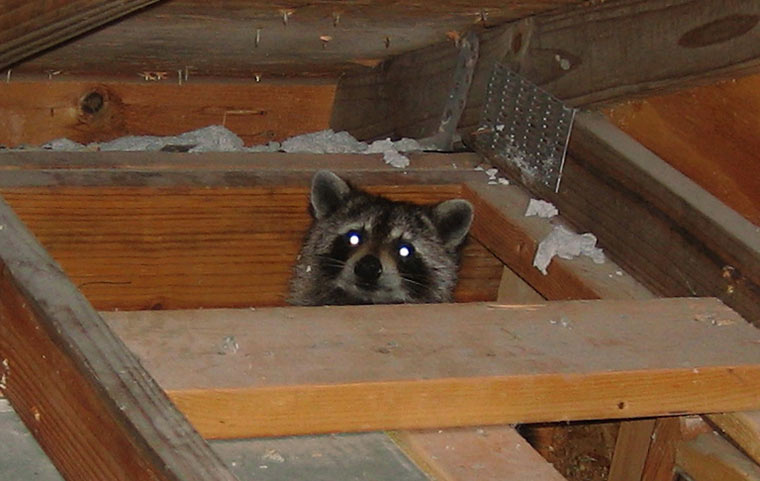- info@wildlife-removal.com
Call us for help in your town
Wildlife Removal Education
What Should I Do About a Raccoon Nest in the Attic?
Need raccoon removal in your hometown? We service over 500 USA locations! Click here to hire us in your town and check prices - updated for year 2020.
The first thing you should do is get a torch and go up to investigate, although you are going to need to remember that you're doing this at your own risk. There are disease threats present with raccoons, and not just from the animal itself; from it's feces, urine, nesting and bedding material, and also from materials that it has chewed or scratched through.

Also read about:
How to get raccoons out of the attic
Types of Damage Caused By Raccoons in the Attic
Raccoons in the Attic: Are There Babies?
Raccoons & Homeowners Insurance: Am I Covered?
5 Signs of Baby Raccoons in the Attic
Raccoon in the Attic: The Signs
When you have a nest of raccoons in the attic, it means that a mother has broken in and set up a little home there. You will need to find the entry point — the point at which she managed to break in. There may be more than one entry point; you will need to find them all.
Once you have figured out where the raccoons are getting in, you can seal those spaces up, but you can't do that all the time the animals are still in your attic. Locking a mother out with her babies is fruitless, because then you will still need to find, grab, and rehabilitate the young kits, and it'll be a much harder task without the mother to accidentally direct you.
With a little investigative work, you may find that luck lands on your side. Raccoons will regularly move den sites with young kits to make sure they are kept safe and protected. This would be the ideal scenario — you can wait for the raccoon to move all of her young to another site (preferably far away from your patch of land), and then you are free to seal up the holes and put preventative measures in place to stop the rogue raccoon attacks from happening again.
> You MUST seal up all entry points and potential entry points. Raccoons will return to the same nesting spots time and time again, and mothers will even pass the locations down to their kits when they are old enough to start leaving the nest.
If the raccoons don't move along of their own accord, you can try to hurry things along with wildlife eviction fluid. Male raccoons are predators to a female and her kits — they will eat the young, especially weaker ones, right out of the nests, particularly when food is scarce. Eviction fluid, wildlife eviction fluid, or raccoon repellent fluid is made up of the fluids that come from male raccoons, as well as other males that are predators to the animal — coyotes, foxes, wolves, etc. When she smells that familiar scent, the hope is that she will pack up her babies and leave. It doesn't always work, but it's worth a shot. It's also actually the only repellent that we would happily recommend to you. We've found most of the others to be a total waste of time and money. They rarely get the job done, and they certainly don't get the job done properly.
If raccoon eviction fluid doesn't work, you could try your hand at trapping the animals, but when there are babies involved a different kind of trapping plan needs to be put into motion. Firstly, you must locate the youngsters in the nest. If you have heard them, but still haven't located them, you will need to work harder to locate them. With thick gloves on, these youngsters should be grabbed and placed into a trap, preferably with something soft, such as a towel, to make the new home slightly more comfortable.
You can't trap the mother without her babies — the babies will die.
You can't trap the babies without the mother — the babies will die.
You can't trap the babies and the mother without sealing your home — the same raccoons will come right back before long, and other raccoons may also join the party. They communicate these locations, you know?
With the babies safely secured in the back of a trap, they will hopefully act as bait, luring the mother in herself. In a perfect world, you would end up with a trap full of raccoons, mother and babies included.
As with most wildlife removal situations, the perfect world and ideal scenarios very rarely come up. A wildlife rehabilitator will be able to remove the raccoon and the nest of babies, as well as ensuring all holes are sealed. They'll even be able to share their preventative secrets with you. It might seem like the "easy way out" (and the most expensive option), but in this case, the easy way out is the right way out ... and usually the cheapest too!
Go back to the Raccoon Removal page, or learn tips to do it yourself with my How to Get Rid of Raccoons guide.


















